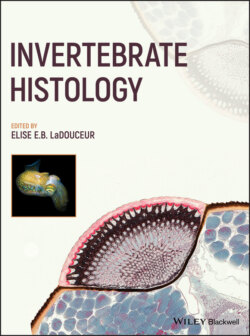Читать книгу Invertebrate Histology - Группа авторов - Страница 17
1.3.2 Water Vascular System
ОглавлениеThe water vascular system is a hydraulic system used for substrate adhesion, locomotion, and in some echinoderms prey manipulation. In many species tube feet also play an important role in respiration and excretion. It is composed of the madreporite, stone canal, circumoral ring canal, radial canal, ampullae, and tube feet (also called podia). The madreporite is a porous ossicle on the aboral surface of sea stars, sand dollars, and sea urchins and the oral surface of brittle stars. In sea cucumbers the madreporite is internal. Also known as the sieve plate, the madreporite functions as a valve which communicates with surrounding sea water. The madreporite and stone canal maintain fluid volume in the water vascular system (Ferguson 1990; Ferguson and Walker 1991). Coelomic fluid fills the water vascular system and is osmotically and ionically similar to sea water (Freire et al. 2011).
Figure 1.14 Histology of the madreporite (a) and stone canal (b) in a mottled star (Evasterias troschelii). 25×, 50×, HE. D, dermis; Dt, digestive tract; E, epidermis; G, gonad; M, madreporite; O, ossicles; S, stone canal.
The madreporite, when present externally on the disc or test, has a surface epithelium similar to the epidermis (Figure 1.14a). It is connected to the stone canal, which consists of scroll‐shaped calcareous rings or spicules (Figure 1.14b). The stone canal connects to the circumoral ring canal that gives rise to five radial canals. In Echinoidea, the ring canal may form a small outpocketing at the top end of each tooth, termed polian vesicles. The radial canals extend into the rays through the ambulacral ossicles, or in Echinoidea to the inner ambulacrum surface (Figure 1.15). These terminate in the tube feet, which consist of an interior bulb (an ampulla) and an external foot (a podium). Ciliated myoepithelium, a combination of muscle cells and support cells that histologically resemble cuboidal epithelial cells, lines the entire interior of the water vascular system (Cavey and Märkel 1994). Cilia create flow in the internal canals to help with fluid transport while muscle contraction generates hydraulic pressure to move the tube feet. Exterior to the myoepithelial lining is a connective tissue layer and an external layer of coelomic epithelial cells.
The ampullae are elongate sacs that may be divided from the radial canal by a valve and have circular and longitudinal layers of muscle fibers. The podia consist of a stalk and terminal disc. They have layers similar to the body wall – an outer epidermis, middle connective tissue layer, and interior coelomic epithelial lining (Hyman 1955). The epidermis of the podia contains larger numbers of secretory cells than the rest of the body. The epidermis of the disc becomes thickened and is composed of ciliated columnar cells, larger numbers of secretory cells and neurosensory cells with a more prominent subepidermal nerve plexus, and is supplied by many subepidermal glands that may include mucous cells and granular secretory cells (Nichols 1961). Subjacent to the glands, the disc may be supported by latticed endoskeletal fragments. In addition to the subepidermal nerve plexus, a podial nerve may be evident coursing longitudinally on one side of the stalk. The stalk consists mainly of a cylinder of collagenous connective tissue (potentially divided into outer thicker longitudinal and inner thinner circular layers), supported by calcareous spicules (Figure 1.16). There is a central lumen (or hydrocoel) lined by a similar myoepithelium as observed throughout the water vascular system. Podia also have thick longitudinal retractor muscles which can contract the podia and push coelomic fluid back into the ampullae.
Figure 1.15 Histology of the water vascular (radial) canal in a white urchin. 200×, HE.
Figure 1.16 Histology of a tube foot in a mottled star. 25×, HE. C, connective tissue; D, disc; E, epidermis; H, hydrocoel; M, muscle; O, ossicle; S, stalk.
